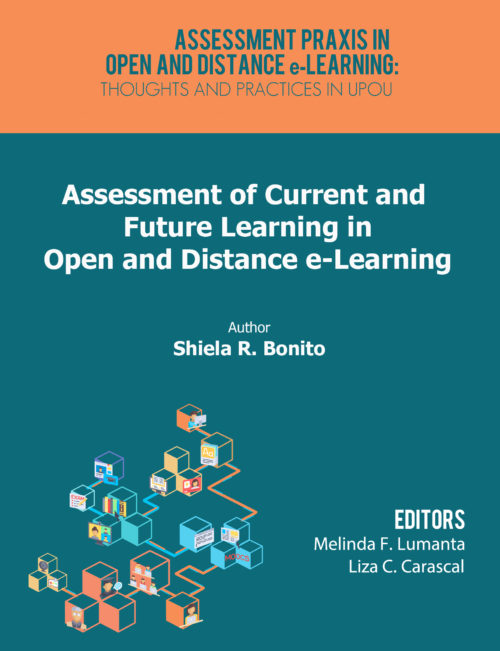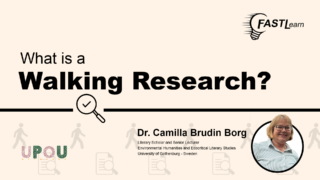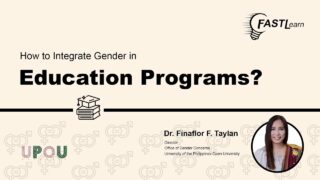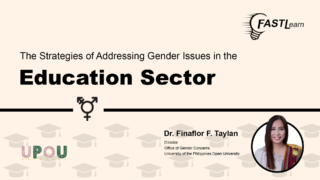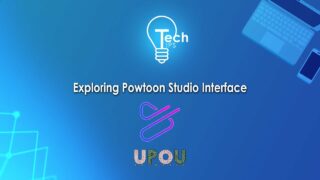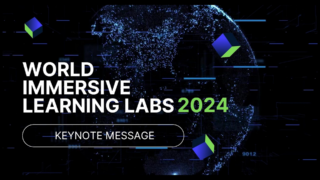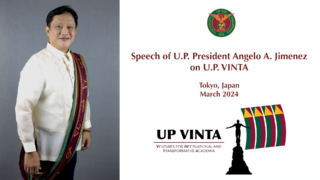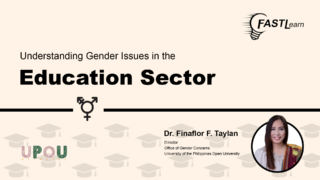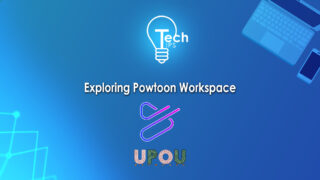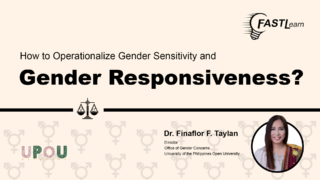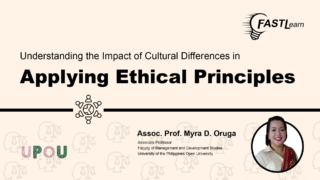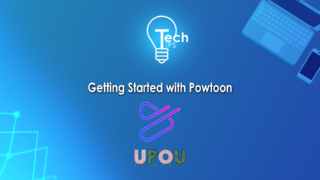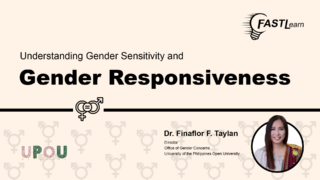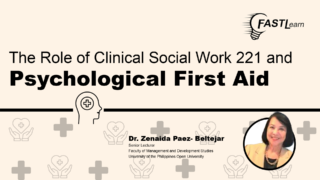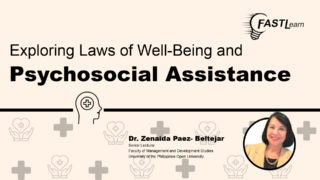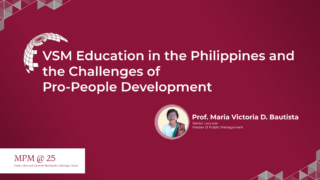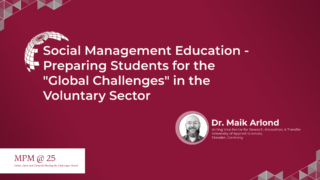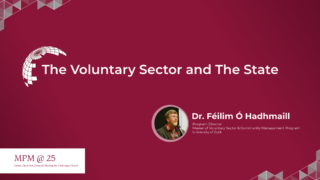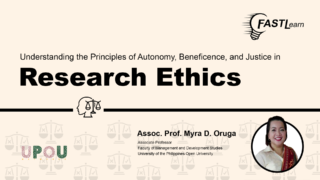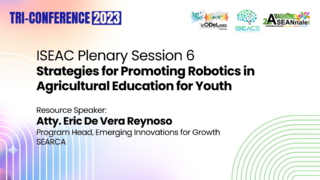Assessment of current learning can be done through the use of formative and summative assessments to ensure that students have achieved the learning objectives of specific courses. Assessment of future learning involves a higher level of learning outcome and needs integrative assessments to ensure that students who went through the programs can meet the needs of the industry or field of practice. This chapter explores how assessment of learning outcomes is done at the UP Open University, particularly in its postgraduate courses in health sciences. The use of formative, summative, and integrative assessment emphasizing student autonomy and authentic learning is showcased. Through the use of assessment rubrics and automated feedback in formative and summative assessment tools, students are encouraged to assess their own learning and that of their peers. Assessment of future learning using integrative assessments and authentic assessments exemplified by e-portfolios, blogs, and wikis are highlighted and evidence of student learning as applied in their different settings are provided.
Open and Distance e-Learning (ODeL) is becoming a popular strategy for many higher education institutions in making quality education accessible and affordable. This arose from the challenge, particularly in developing countries, to provide quality and relevant education that is applicable to future labor markets and to developing the knowledge society (Schwartzman, 2003). Developing countries, like the Philippines, have recognized the potential of ODeL in reaching out to many potential students. The “Open Distance Learning Act” has promulgated expanding access to educational services by institutionalized open and distance learning in levels of tertiary education (Republic Act 10650, 2014). The possibilities of doing online learning even in traditional higher education institutions are being explored and implemented by many state and private universities to harness the power of information and communication technology in education and to meet the growing demands for education in more efficient and more cost-effective means.
The use of Information and Communications Technology (ICT) in ODeL has created a revolution in the development and delivery of courses, offering new and more flexible learning opportunities and empowering both teachers and students. It has also extended to the ways of assessing learning outcomes. The need for timely feedback to facilitate student learning and autonomy has never been more crucial than in ODeL. Crisp (2012) proposes a need to make a clear distinction between assessment of current and future learning. Learning is not only about progressing through the courses for certification purposes, but also building capacity of the current and/or future work force. Assessment of current learning can be done through the use of formative and summative assessments to ensure that students have achieved the learning objectives of specific courses. Assessment of future learning involves a higher level of learning outcome and needs integrative assessments to ensure that students who went through the program/s can meet the needs of the industry or field of practice.
Assessment of learning outcomes in ODeL also means that teachers need to think of using technology in giving formative, summative, and integrative assessments. Learning management systems that make formative and summative assessments easy use built-in features like online quizzes and games. These features also allow immediate feedback to individual students, facilitating student autonomy and self-direction. Integrative assessments can also be made through the use of e-portfolios where students are tasked to assemble a number of critical outputs as evidence of their learning. Kuh et al. (2014) studied the current state of student learning outcomes assessment in United States’ Colleges and Universities showing that the range of tools and measures to assess student learning have expanded significantly especially in the use of rubrics, portfolios, and other classroom-based assessments.
This chapter explores how assessment of learning outcomes is done at the UP Open University, particularly in its postgraduate courses in health sciences. The use of formative, summative, and integrative assessment emphasizing student autonomy and authentic learning is showcased.
Assessment is the ongoing process of gathering, analyzing, and reflecting on evidence to make informed and consistent judgments to improve future student learning (Victoria State Department, 2017). Assessment has multiple purposes. One of the traditional purposes of assessment is determining the level of achievement of a student and/or between students. This confirms that certain knowledge, skill, and/or attitude has been demonstrated. There are other purposes such as: (1) assessment for learning (formative), (2) assessment as learning (formative), and (3) assessment of learning (summative).
Formative assessment can be described as “assessment for learning” from the teacher’s perspective and “assessment as learning” from the student’s point of view. Assessment for learning occurs when teachers use inferences about student progress to inform their teaching. Assessment as learning occurs when students reflect on and monitor their progress to inform their future learning goals.
The teachers’ role is central in the assessment for learning. Through assessment for learning, teachers ascertain students’ prior knowledge, perceptions, and misconceptions and use these evidences to inform curriculum planning and teaching practice. This type of assessment establishes a classroom culture that encourages interaction and the use of assessment tools. It occurs throughout a learning sequence and is planned when teachers design teaching and learning activities. It involves teachers sharing learning intentions and explicit assessment criteria with students. It involves both teachers and students setting and monitoring student progress against learning goals. Assessment for learning thus provides sensitive and constructive feedback to students on their performance.
Assessment as learning establishes students’ roles and responsibilities in relation to their learning and assessment. It engages students in self- and peer-assessment and promotes students’ confidence and self-esteem through an understanding of how they learn. Its focus on student reflection on their learning is powerful in building metacognition and students’ ability to plan for their own future learning goals.This type of assessment involves students monitoring their learning and using feedback from this monitoring to make adjustments and changes to their skills and understandings. It establishes students’ role and responsibility in relation to their learning and assessment. It empowers students to consider strategies for learning and taking action. It involves students in self-assessment and peer-assessment.
Assessment as learning also promotes students’ self-esteem and self-confidence through an understanding of how they learn to learn. It develops students’ capacity to reflect on their learning and to contribute to their future learning goals. It enhances students’ lifelong learning skills and emphasizes the process of learning as experienced by the students.
The use of automated feedback in online quizzes and/or the use of criteria in discussion forum posts are examples of formative assessments that are very useful in aiding students in assessing their performance (See Figure 1 and Figure 2).
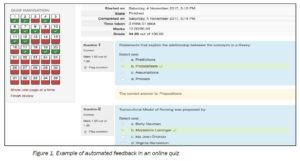
Figure 1. Example of automated feedback in an online quiz
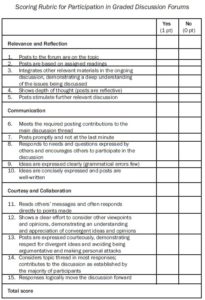
Figure 2. Example of an assessment rubric for participation in a discussion forum
Assessment of learning occurs when teachers use evidence of student learning to make judgments on student achievement against goals and standards. Assessment of learning describes the extent to which a student has achieved the learning goals, including the standards, and demonstrates what the student knows and can do. Its purpose is summative and gives an “overview of previous learning” (Black & William, 1998). This is the type of assessment that is used to certify learning for reporting to students, the parents, and the system. It takes place usually at the end of a unit, a program, a semester, or a year of study. It is based on teacher moderation to ensure consistent judgment of student achievement and is supported by examples or evidence of student learning. Assessment of learning can be used to plan for future learning goals. Assessment of learning enables students to demonstrate what they know and can do. It describes the extent to which a student has achieved the learning goals, including standards. It uses teacher judgments about student achievement at a point in time and is supported by examples or evidence of student learning. Further, it ensures consistent teacher judgments through moderation processes and is used to plan future learning goals. End of term projects and/or final exams are examples of summative assessment frequently used in the health science courses (See Figure 3)
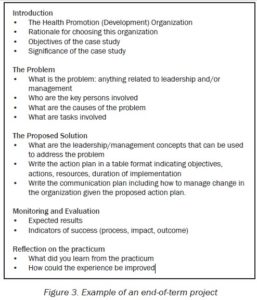
Figure 3. Example of an end-of-term project
.
Integrative assessment allows the learner to demonstrate applied competence and uses a range of assessment methods. This entails providing feedback or judgment on students’ ability to be self-regulated learners, to identify and use standards, and to apply their capabilities to future learning situations by being able to articulate their strategies or approaches to responding to a task or situation (Crisp, 2012). As such, students are provided with opportunities to do as follows: (1) make judgments about their own learning or performance through review and critique; (2) define standards and expectations in their response; (3) track and analyze their approaches to responding to a problem, issue, situation, or performance; (4) integrate prior or current feedback into their response; and (5) engage in a meaningful task that has inherent worth beyond just an assessment activity. More importantly, in assessment of learning, students are rewarded for the quality of their analysis of metacognitive abilities, rather than factual knowledge or specific performance.
Uses of e-portfolio, blogs, or wiki are examples of integrative assessment where the focus is on quality of analysis of approaches to learning (rather than learning itself). Asking students to reflect on what they have learned also adds to their understanding of the lesson as well as its application to their future learning (See Figure 4).
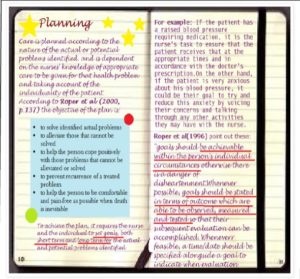
Figure 4. Example of a blog developed by students
Students need to develop as independent learners to be successful in their higher education programs and also in their professional lives post-graduation. Boud and Falchikov (2007) have described the ability to evaluate one’s learning and performance as an essential part of “becoming an accomplished and effective professional.” Similarly, Biggs and Tang (2007) argue that the ability to make judgments about whether a performance or product meets a given criteria is vital for effective professional action in any field. Tan (2007) also advocates for “self-assessment development practices that can develop and sustain students’ self-assessment ability beyond their immediate program of study”. However, part of this preparation for the future requires helping students to learn to continuously monitor the quality of their work during the act of production itself, so they can make improvements in real time (Montgomery, 2000; Sadler, 1989).
Whereas assessment of current learning can be done through the use of formative and summative assessments to ensure that students have achieved the learning objectives of specific courses, assessment of future learning involves a higher level of learning outcome and needs integrative assessments to ensure that students who went through the program/s can meet the needs of the industry or field of practice (Crisp, 2012).
Some approaches in assessment of future learning include authentic assessment. Authentic assessment measures student performance in a direct and relevant way to see if the learning objectives were met. Some common examples are projects such as reports, journals, speeches, videos, and interviews where students are challenged to demonstrate their understanding of the subject material by asking them to apply it in their own experience. Authentic assessments help students analyze what they have learned and apply it in their own experience. They do not have to memorize facts for a test, so they can use their creativity to show what they have learned. For older students who can use a combination of writing and speaking, authentic assessment helps them refine their writing and oral presentation skills. Moreover, authentic assessment works great for groups, so students can experience collaborating on projects with their peers. Students are also often asked to make a reflection on the given task and how it impacts on their own work setting.
As an example, students in a theoretical foundations course in nursing were required to create a blog featuring one nursing theory and to discuss its concepts and applications. Students were also asked to comment on how the theory or model influenced their nursing practice (See Figure 5).
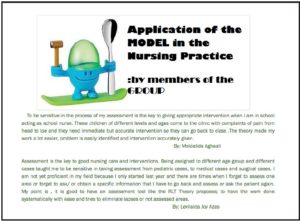
Figure 5. Example of student reflections on a particular activity
With a student population scattered worldwide, it is challenging to devise assessment tools and measures that would facilitate immediate and individualized feedback. Through the use of assessment rubrics, automated feedback, and self- or peer- assessments in formative and summative assessment tools, students are encouraged to assess their own learning and that of their peers. The use of e-portfolios encourages authentic learning by having students collect evidence of learning as applied in their different settings and contexts. This also allows assessment of future learning, that is, an evaluation of tasks and competencies needed by the industry and/or field of practice in the near future.
Several reflection questions come to mind to ensure that we make use of all three main purposes of assessment.
- Do our assessment processes allow for a balance of assessment for, as and of learning?
- Do our assessment tools allow for assessment of future learning?
- How can we design integrative assessments that will help future learning?
Assessment of learning outcomes in ODeL is a critical and significant aspect of education. It is not only imperative in monitoring and evaluating student progress but also crucial in influencing program reviews, curriculum modification, policy development, and institution accreditation to make education relevant to society’s current and future needs.
Black, P. & William, D. (1998). Assessment and classroom learning. Assessment in Education: Principles, Policy & Practice, 5(1).
Boud, D., & Falchikov, N. (2007). Developing assessment for informing judgment. In D. Boud & N. Falchikov (Eds.), Rethinking assessment in higher education: Learning for the longer term, pp. 181-197. London: Routledge
Crisp, G. T. (2012). Integrative assessment: Reframing assessment practice for current and future learning. Assessment & Evaluation in Higher Education, 37(1). Available at http://www.tandfonline.com/doi/abs/10.1080/02602938.2010.494234
Kuh, G.D., Jankowski, N., Ikenberry, S.O., Kinzie, J. (2014). Knowing what students know and can do: The current state of student learning outcomes assessment in US Colleges and Universities. National Institute for Learning Outcomes Assessment. Available at http://learningoutcomesassessment.org/documents/2013%20Survey%20Report%20Final.pdf
Montgomery, K. (2000). Classroom rubrics: Systematizing what teachers do naturally. Clearing House, 73(6), 324-328.
Republic Act 10650 “Open and Distance Learning Act”, Sixteenth Congress (Dec 2014). Available at http://www.gov.ph/2014/12/09/republic-act-no-10650/
Sadler, D. R. (1989). Formative assessment and the design of instructional systems. Instructional Science, 18(2), 119-144
Schwartzman, S. (2003). The challenges of education in Brazil. Available at http://www.drclas.harvard.edu/files/Simon-Schwartzman-Challenges-of-Education-in-Brazil.pdf
Tan, K. (2007). Conceptions of self-assessment: What is needed for long term learning? In D. Boud & N. Falchikov (Eds.), Rethinking assessment in higher education: Learning for the longer term (pp. 114-127). London: Routledge.
Victoria State Department Education and Training (2017). Retrieved from http://www.education.vic.gov.au/school/teachers/support/Pages/advice.aspx
Bonito, S. R. (2018). Assessment of Current and Future Learning in Open and Distance e-Learning (Eds.), Assessment Praxis in Open and Distance e-Learning: Thoughts and Practices in UPOU (pp. 1-13). Los Baños, Laguna, Philippines: UP Open University
